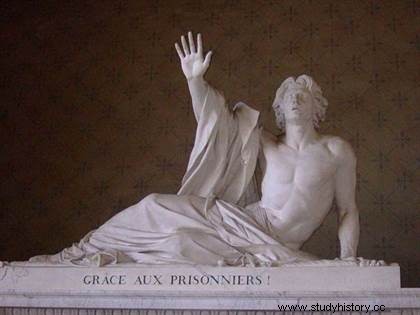 The Bonchamps Pardon is a tomb to the glory of the Vendée chef , which was paradoxically made in the 19th century by David d'Angers (1788-1856), the descendant of one of his enemies. As a sign of reconciliation it was under the hammer blows of the son of a republican soldier that this block of marble was transformed into the apotheosis of the royalist general and, through him, into an exaltation of kindness and triumphant humanism!
The Bonchamps Pardon is a tomb to the glory of the Vendée chef , which was paradoxically made in the 19th century by David d'Angers (1788-1856), the descendant of one of his enemies. As a sign of reconciliation it was under the hammer blows of the son of a republican soldier that this block of marble was transformed into the apotheosis of the royalist general and, through him, into an exaltation of kindness and triumphant humanism!
Monsieur de Bonchamps, Vendée general
Charles Melchior Artus, Marquis de Bonchamps, was born in 1760 in Jurvadeil (Anjou). He served in India and was serving in the royal army when the French Revolution broke out in 1789. He then had to take refuge in his domain of Barronière where the rebellious peasants came to seek him in 1793 to march at their head. He invests part of his personal fortune to equip his small contingent. A cautious general, he regularly faced the Republican armies without the fate always being favorable to him.
October 17, 1793 he took part in the indecisive Battle of Cholet which resulted in a Vendée defeat. The insurgents leave about 8,000 men on the battlefield, Bonchamps is mortally wounded. The Catholic and royal army withdrew to Saint-Florent-le-Vieil with 5,000 prisoners and the dying general.
Defeated, the Vendée peasants, embittered by the loss of their comrades, want to avenge them by executing the Republican prisoners. The massacre is preparing, the city is in emulation, the bloodthirsty intentions of its men reach Bonchamps who is dying. Appalled by this behavior, he gives his last order:pardon the prisoners! His cousin, from Autichamp, jumps on his horse and rushes towards those who are about to commit the irreparable. Charitable and unexpected, the order bursts and spreads like wildfire in the city:“Thank you! Thanks to the prisoners! Bonchamps wants it! Bonchamps orders it! ". This event has become a true Epinal image of the history of the Vendée wars, the parallel being very clear for the supporters of the Catholic and royal army between the forgiveness of Bonchamps dying and the words of Jesus Christ expiring on the cross. "Forgive them, for they don't know what they are doing (Luke, XXIII, 34).
The general's last wishes are respected and the Republicans are released against the commitment not to serve against the Vendée armies. Bonchamps expires on October 18 and is buried in Saint-Florent-le-Vieil.
Bonchamps' charity was not specially rewarded, the Republican soldiers were forced to take up arms again against those who had pardoned them and they were instructed not to mention this act of generosity. They were asked to say that they had been rescued from the clutches of the rebels by the Republican army. It is sometimes difficult to admit the good when you see it in your worst enemy...

The work of David d'Angers
Pierre Jean David, known as David d'Angers, did not take part in the events since he was born in 1788. A sculptor, he began his career under the First Empire ( he will then work on the friezes of the Arc de Triomphe). He continued his career under the Restoration and even became a professor at the School of Fine Arts in Paris.
When in 1817 a subscription was launched to create the tomb of General Bonchamps, David showed a certain eagerness to participate in the enterprise! Why ? Quite simply because his father was one of the 5,000 prisoners before the life of this man...
He therefore produced the tomb (1825), obviously taking as its theme this scene which saved his father:Bonchamps on his dying bed stands up and raises his hand to put an end to the slaughter that is preparing, his parted lips pronounce this sentence engraved on the tomb “Thanks to the prisoners! ". The style is perfectly neoclassical, the treated wounded is an opportunity to work on a body magnified in its heroic nudity and the drapery in a pure antique style. As for the face, it is already marked with a certain baroque romanticism:the loose hair, the face contorted by a pain which seems as much to be the physical pain of agony as the moral pain of the behavior of men. His parted lips let out what seems to be his last breath, which by leaving takes the life of a man and saves 5,000...
Materialization of humanity, the tomb is still visible today in the church of Saint-Florent-le-Vieil, a copy is exhibited in the museum of Angers.
